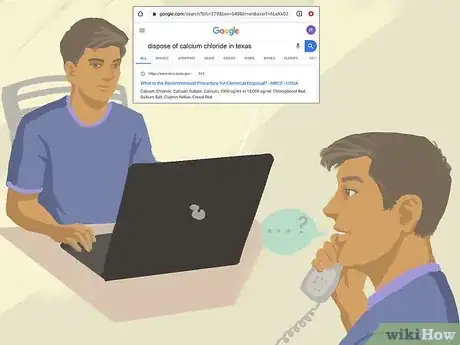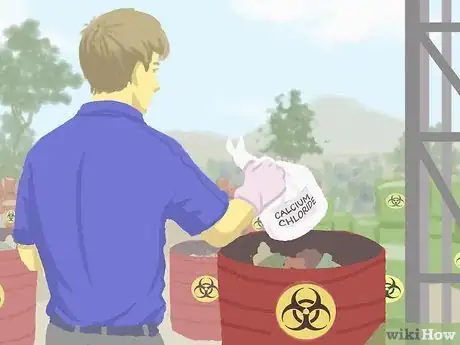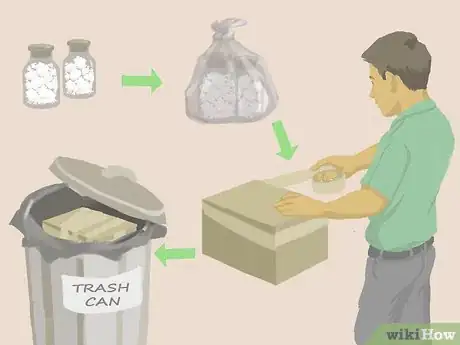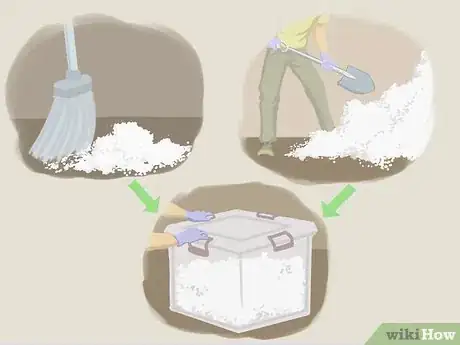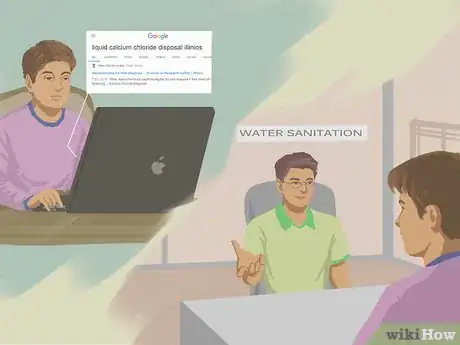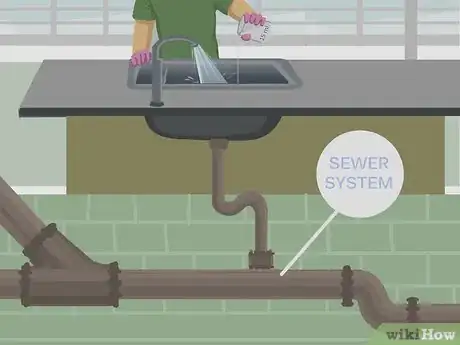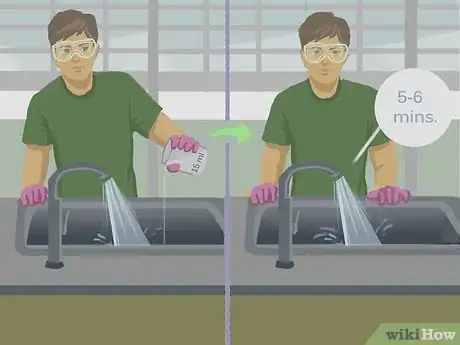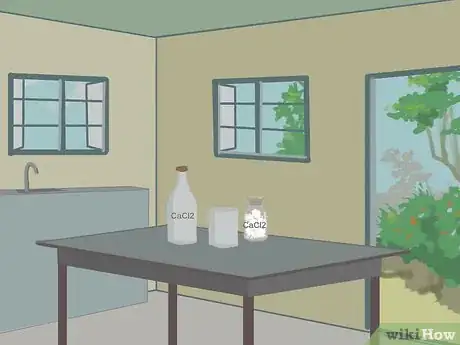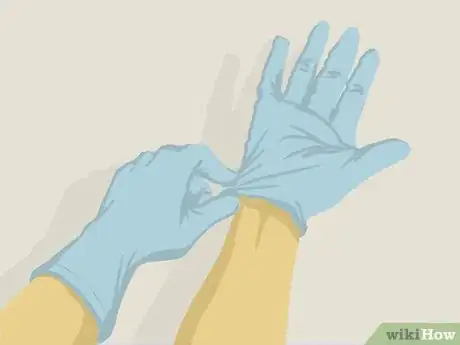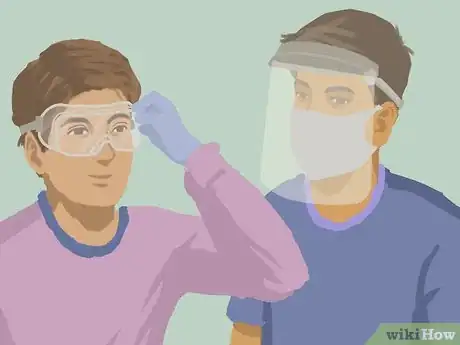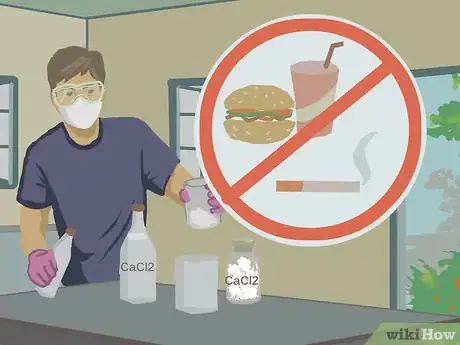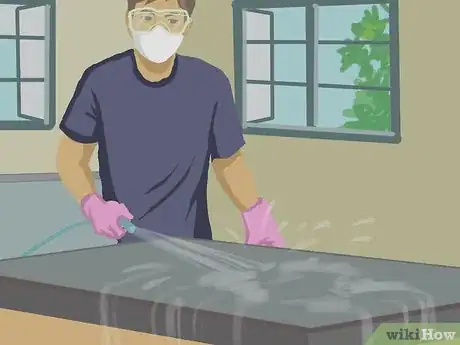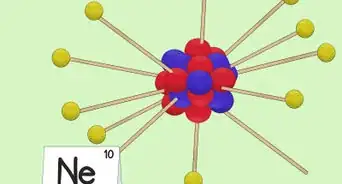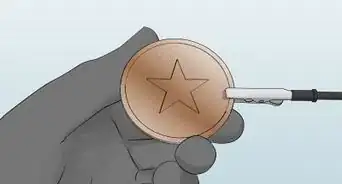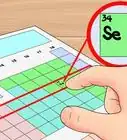This article was co-authored by wikiHow staff writer, Megaera Lorenz, PhD. Megaera Lorenz is an Egyptologist and Writer with over 20 years of experience in public education. In 2017, she graduated with her PhD in Egyptology from The University of Chicago, where she served for several years as a content advisor and program facilitator for the Oriental Institute Museum’s Public Education office. She has also developed and taught Egyptology courses at The University of Chicago and Loyola University Chicago.
There are 10 references cited in this article, which can be found at the bottom of the page.
This article has been viewed 23,649 times.
Learn more...
Calcium chloride, or CaCl2, is a chemical with a variety of household and industrial uses. It’s a powerful dehumidifier and a great de-icing agent, and can also help reduce dust on roads. In many areas, you can dispose of CaCl2 in the regular trash if it’s solid, or by washing it down the drain if it’s in liquid form. However, it’s important to check local chemical disposal laws first. Take care when handling CaCl2, since it can irritate your skin, eyes, and respiratory tract.
Steps
Throwing Away Solid CaCl2
-
1Search online or contact your local government for disposal information. CaCl2 is not considered a hazardous waste material by the National Institute of Occupational Health and Safety in the U.S.[1] However, in some areas, there may still be special laws and regulations governing how you can dispose of it, especially in a solid state. Before throwing away any solid CaCl2, do a search online or ask someone at your local health department to find out about restrictions in your area.[2]
- For example, do a search using terms like “Dispose of calcium chloride in Texas.”
-
2Bring solid CaCl2 to a hazardous waste disposal site if local laws require it. If your local government treats solid CaCl2 as hazardous or “special” waste, you’ll need to bring it to an approved facility or use a qualified waste disposal service.[3] Visit your government’s waste management website or contact your local health office for more information about where to dispose of your unwanted CaCl2.
- For example, in Illinois, all solid chemical waste is classified as “special waste,” and it’s against the law to throw it away in the regular garbage.[4]
- Some areas offer special hazardous waste collection events or pickup services for residences and businesses.
- Many colleges and universities have their own services for disposing of chemical waste from campus labs.
Advertisement -
3Put solid CaCl2 in a sealed box in the trash if local law allows it. In many areas, it’s legal to dispose of CaCl2 in the regular trash. If this is the case where you live, put closed containers of CaCl2 inside a box lined with a plastic bag. Tape up the box and put it in your trash can.[5]
- Don’t dump solid CaCl2 directly into your trash or into a dumpster. If someone came into contact with the material while handling the trash, it could irritate their eyes, skin, or respiratory system.[6]
- Depending on local laws, there may be limits on how much solid chemical waste you can dispose of in the regular trash. For example, in some areas, you can’t throw away more than 10 pounds (4.5 kg) of non-hazardous chemical waste at a time. You may need to take larger amounts to a hazardous waste disposal site.[7]
-
4Sweep or shovel unused solids into airtight containers for reuse. If you have leftover solid CaCl2, you may be able to reuse or recycle it.[8] Carefully sweep up any unused portion (or use a shovel, if you’re dealing with a large amount) and place it in a container that you can seal, such as a plastic tub.[9]
- Work carefully so you don’t stir up a lot of dust, since it can be irritating to your eyes and respiratory tract.
- Store the closed containers in a dry area to prevent the CaCl2 from liquefying.
Disposing of Liquid CaCl2 Solutions
-
1Look up your area’s laws about disposing of CaCl2 solutions. In most areas, calcium chloride is considered safe to pour down the drain as long as it’s in an aqueous solution (dissolved in water).[10] However, this may not be true everywhere. Always check with your local water and sewerage department first.
- For example, do a search like “liquid calcium chloride disposal Illinois.” You could also contact your local water or sanitation department directly.
-
2Flush liquid CaCl2 down a drain connected to the sewer system. If local laws and regulations allow it, dispose of liquid CaCl2 by pouring it into your sink or tub while running water to dilute it. Make sure to use a drain that’s connected to your sewer system, since that water will eventually be routed to a wastewater treatment plant.[11]
- Avoid pouring liquid CaCl2 directly into local waterways, since it can be harmful to plants and animals and may contribute to heavy metal contamination.[12]
Did you know? If left in an open container, CaCl2 will quickly absorb water from the air and become a liquid. If this happens, you can dispose of the resulting liquid by diluting it with water and washing it down the drain.
-
3Dilute liquid CaCl2 while you flush it with 10-20 times its volume in water. You can dispose of liquid CaCl2 more safely if you dilute it. Run the water in the sink for several minutes as you pour it down the drain, or mix your CaCl2 with a generous amount of water before dumping it.[13]
- For example, if you have 15 millilitres (0.063 c) of CaCl2 solution, wash it down the sink with 150–300 millilitres (0.63–1.27 c) of water.
- If you run the faucet while dumping the CaCl2 down the drain, let the water continue to run for 5-6 minutes after you’re done.
Handling Calcium Chloride Safely
-
1Work with CaCl2 in a well-ventilated area. Inhaling CaCl2 can irritate your nose, throat, and lungs.[14] If you need to use CaCl2, work outdoors, in a well-ventilated room (i.e., with open windows or doors), or under a fume hood.[15]
- If your work is likely to stir up a lot of dust, wear a ventilator mask with a particulate filter to help prevent inhalation.
- Inhalation of CaCl2 is not known to cause long-term harmful effects. However, if you have concerns or if you experience symptoms (such as a sore throat, coughing, or burning in your throat or lungs) that don’t get better after you move to fresh air, call your doctor.
-
2Put on rubber gloves before handling CaCl2. Calcium chloride can irritate your skin. Wear rubber gloves to protect your hands during handling or cleanup.[16]
- If you get CaCl2 on your skin, take off any contaminated clothes and wash your skin with running water and soap. See a doctor if you experience burns or irritation.
-
3Wear safety goggles or a face shield to protect your eyes. If you get CaCl2 in your eyes, it can cause severe irritation and abrasions on your corneas.[17] Keep your eyes safe by wearing a face shield or chemical safety goggles, preferably with side shields. Never wear contacts while working with CaCl2, since they can trap the chemical against your eye and concentrate it, leading to more severe injuries.[18]
- If you get CaCl2 in your eye, flush it with water for at least 15 minutes, then see an eye doctor. If you do happen to be wearing contacts, remove them immediately.
-
4Don’t drink, eat, or smoke while handling CaCl2. CaCl2 can irritate your digestive tract, causing symptoms like nausea, vomiting, and burns in your mouth and throat. To prevent accidental ingestion, don’t put anything in your mouth while working with CaCl2.[19]
- If you accidentally swallow some CaCl2, don’t induce vomiting. Rinse your mouth with water and drink 1 or 2 large glasses of water or milk, then seek medical attention.
-
5Wash away residue with plenty of water. If you’re cleaning up a CaCl2 spill, rinse the area with plain water when you’re done. This will help dilute and dissolve any remaining residue, and will also help prevent the distribution of irritating dust.[20]
- Moistening a solid spill with a little water before you clean it up can help minimize dust.
Warnings
- Calcium chloride can irritate your eyes, skin, respiratory tract, and gastrointestinal tract. Always handle it with caution and use appropriate protective gear, such as rubber gloves, safety goggles, and a dust-filtering mask.[21]⧼thumbs_response⧽
References
- ↑ https://publicsafety.lafayette.edu/wp-content/uploads/sites/86/2011/06/Disposal-of-Solid-Chemicals-in-the-Normal-Trash.pdf
- ↑ https://www.nrcs.usda.gov/Internet/FSE_DOCUMENTS/nrcs142p2_052293.pdf
- ↑ https://drs.illinois.edu/Page/Waste/DisposalofLiquidNonHazardousChemicals
- ↑ https://drs.illinois.edu/Page/Waste/WasteRestrictionsDefinitionsLawsAndRegulations#IllinoisSpecialWaste
- ↑ https://publicsafety.lafayette.edu/wp-content/uploads/sites/86/2011/06/Disposal-of-Solid-Chemicals-in-the-Normal-Trash.pdf
- ↑ https://pubchem.ncbi.nlm.nih.gov/compound/Calcium-chloride
- ↑ https://www.lincolnu.edu/c/document_library/get_file?uuid=d4600066-aa07-421e-81f1-95cc163af191&groupId=375800
- ↑ https://westliberty.edu/health-and-safety/files/2012/08/Calcium-Chloride.pdf
- ↑ https://pubchem.ncbi.nlm.nih.gov/compound/Calcium-chloride
- ↑ https://www.uwgb.edu/safety-environmental-management/environmental-policies/materials-safe-for-sewer/
- ↑ https://www.uwgb.edu/safety-environmental-management/environmental-policies/materials-safe-for-sewer/
- ↑ https://stormwater.pca.state.mn.us/index.php/Environmental_impacts_of_road_salt_and_other_de-icing_chemicals
- ↑ https://drs.illinois.edu/Page/Waste/DisposalofLiquidNonHazardousChemicals
- ↑ https://pubchem.ncbi.nlm.nih.gov/compound/Calcium-chloride
- ↑ http://datasheets.scbt.com/sc-207392.pdf
- ↑ https://pubchem.ncbi.nlm.nih.gov/compound/Calcium-chloride
- ↑ https://pubchem.ncbi.nlm.nih.gov/compound/Calcium-chloride
- ↑ http://datasheets.scbt.com/sc-207392.pdf
- ↑ https://pubchem.ncbi.nlm.nih.gov/compound/Calcium-chloride
- ↑ https://pubchem.ncbi.nlm.nih.gov/compound/Calcium-chloride
- ↑ https://pubchem.ncbi.nlm.nih.gov/compound/Calcium-chloride
